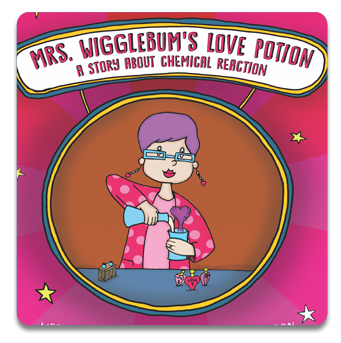In the book, Mrs. Wigglebum’s Love Potion, Liza suspects Freddie is in “love.” Mrs. Wigglebum plays a Valentine’s Day joke, by making a so-call love potion, as a fun twist to teaching about chemical reactions. After all, what child doesn’t like to create potions or concoctions--something that seems to behave in a truly magical way—bubbling, growing, or changing color? And who hasn’t had a Valentine crush??? You’ll have to read the story and watch our video to learn more.
Of course in real life it’s impossible to create love potions. Or is it? The answer may be yes and no.
It is impossible to replicate true love, since it's an emotional, cognitive process that's based on experiences and memories. There's no scientific pill, elixir, or concoction for that. But it has been proven that there are specific chemicals related to emotional states similar to love—at least in animals.
A chemical hormone called a pheromone stimulates the part of our brains that increases our feelings of longing and attraction. Based off of that, various oils and perfumes have been created that include these pheromones, which supposedly attract the opposite sex.
Researchers (as well as fragrance companies) have been hoping to find a human sex pheromone for decades, but so far the search has failed. Instead perfume companies have tried to capitalize on the potential sex-specific effects of these chemicals by adding animal hormones—mainly pig or deer-- to their fragrances. Pheromones are generally species-specific, however, so a perfume enhanced with pig pheromones is really only useful for other pigs in all likelihood.
How did this research come to be? It is believed that the first pheromone was identified in 1953. Bombykol is secreted by female moths and is designed to attract males. The pheromone signal can travel enormous distances, even at low concentrations. Now insect pheromones are commonly used in insect control. They can be used as bait to attract males into a trap, prevent them from mating, or to disorient them.
And while we haven’t found this type of pheromone in humans, using brain imaging, Swedish researchers have found evidence that men and women can in fact send and receive subconscious odor signals.
It’s also interesting to note, most animals smell or "sense" pheromones through a specialized half-moon shaped structure located inside the nose called the vomeronasal organ. Pheromone signals picked up by the organ are then relayed through nerves to an area of the brain called the hypothalamus, which is well known for its ability to alter emotions, hormones, reproduction, and sexual behavior. Ordinary, non-pheromone smells such as the scents of food or flowers are recognized by a different part of the nose called the olfactory epithelium.
So for now, don’t count on a potion, concoction or your favorite perfume to tamper with the “falling in love” process. You will just have to let nature take its course. But who knows what scientists may discover in the future!
